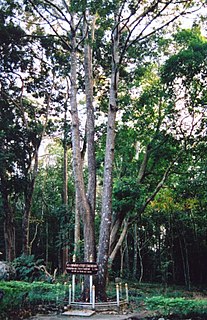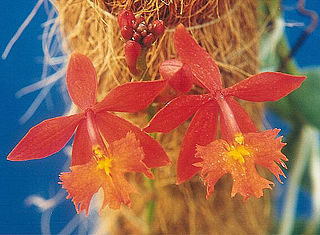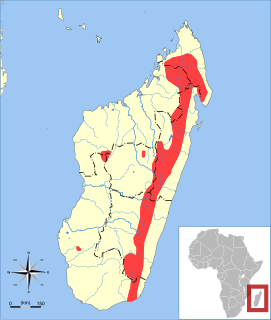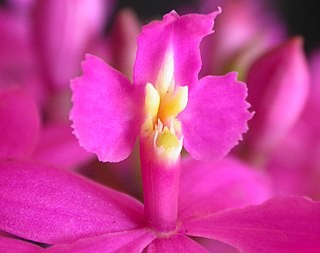
Shorea is a genus of about 196 species of mainly rainforest trees in the family Dipterocarpaceae. The genus is named after Sir John Shore, the governor-general of the British East India Company, 1793–1798. The timber of trees of the genus is sold under the common names lauan, luan, lawaan, meranti, seraya, balau, bangkirai, and Philippine mahogany.

The white-tipped tufted-tailed rat is a rodent endemic to Madagascar. It is known from only two specimens, one collected from Ampitambe forest in 1895 or 1896 and the second in 2000. It is listed by the International Union for Conservation of Nature (IUCN) as an endangered species due to habitat loss.

The Telefomin cuscus is a critically endangered possum found on New Guinea.

Epidendrum radicans is a species of orchid. Common names include ground-rooting epidendrum, fire-star orchid, rainbow orchid, and reed-stem epidendrum. It is a common roadside weed at middle elevations in Central America. It is a crucifix orchid, often confused with many other members of the section Schistochila, including E. calanthe, E. cinnabarinum, E. denticulatum, E. erectum, E. fulgens, E. ibaguense, E. imatophyllum, E. incisum, E. schomburgkii, E. secundum, and E. xanthinum, among others. The diagnostic characteristic of E. radicans is its tendency to sprout roots all along the length of the stem; other crucifix orchids only produce roots near the base. Additionally, E. radicans flowers are resupinate, unlike the members of the Epidendrum secundum complex, E. fulgens, and many other crucifix orchids. E. radicans also differs from E. secundum by bearing no nectar in the flower.

A species that is extinct in the wild (EW) is one that has been categorized by the International Union for Conservation of Nature as known only by living members kept in captivity or as a naturalized population outside its historic range due to massive habitat loss.

Humboldt big-eared brown bat is a species of vesper bat in the family Vespertilionidae. It is found in Colombia and Venezuela.
The Ethiopian long-eared bat or Ethiopian big-eared bat is a recently described species of long-eared bat in the family Vespertilionidae.

The Gomantong myotis is a species of bat in the family Vespertilionidae that is endemic to Sabah district of Malaysia.
The Sulawesi forest turtle is a critically endangered species of turtle in the family Geoemydidae. The species is monotypic within the genus Leucocephalon. It is endemic to Sulawesi in Indonesia.

The black dorcopsis or black forest wallaby is a species of marsupial in the family Macropodidae. It is endemic to an island at the eastern end of New Guinea where its natural habitat is subtropical or tropical dry forests. It is threatened by habitat loss and hunting, its population is declining and the IUCN lists it as being "Critically endangered".

Major's long-tailed tenrec is a species of mammal in the family Tenrecidae. It is endemic to Madagascar. Its natural habitat is the eastern humid forest of the island, as well as some western forests, where it has been seen at elevations from 785 to 2000 m. Its habits are not well known, but it is thought to be semiarboreal. The species was formerly viewed as synonymous with M. longicaudata. It was named in honor of zoologist C. I. Forsyth Major.

The elongated shrew is a species of mammal in the family Soricidae. It is endemic to the island of Sulawesi in Indonesia. It lives in the forests of central, northern, and eastern Sulawesi from 200 to 2000 meters elevation.

The Andaman spiny shrew or Andaman shrew is a species of mammal in the family Soricidae. It is endemic to India. Its natural habitat is subtropical or tropical dry forests. It is threatened by habitat loss.

The long-tailed mole is a species of mole in the family Talpidae. It is found in China, Vietnam and Myanmar.

Day's shrew is a species of mammal in the family Soricidae. It is endemic to India. Its natural habitat is subtropical or tropical dry forests. It is threatened by habitat loss.

The Sakeji horseshoe bat is a species of bat in the family Rhinolophidae. It is endemic to Zambia. Its natural habitats are subtropical or tropical dry forest, subtropical or tropical moist lowland forest, and moist savanna, especially Zambia, Mwinilunga District, Ikelenge Pedicle between the Sakeji and Zambezi rivers, approximately 11 km NNE of source of Zambezi River, Kavunda, 11°17'S, 24°21'E, 1,388 m. It is threatened by habitat loss. It was discovered in 2000.
Schistochila is a genus of liverwort in family Schistochilaceae. It contains the following species :
Schistochila undulatifolia is a species of liverwort in the family Schistochilaceae. It is endemic to Papua New Guinea. Its natural habitat is subtropical or tropical dry forests. It is threatened by habitat loss.

Epidendrum sect. SchistochilaRchb.f. (1861) is a section of the subgenus E. subg. AmphiglottiumLindl. (1841) of the Genus Epidendrum of the Orchidaceae. E. sect. Schistochila differs from the section E. sect. Holochila in that the species in E. sect. Holochila have undivided lips; the species in E. sect. Schistochila have lobate lips. The species in both E. sect. Schistochila and E. sect. Holochila have racemose inflorescences, unlike those in E. sect. Polycladia, which have truly paniculate inflorescences. Like the other sections of E. subg. Amphiglottium, the members of E. sect. Schistochila are sympodial orchids bearing thin stems with alternate leaves, a long peduncle covered with thin, imbricating sheathes, and a lip adnate to the very end of the column.

Olearia macrodonta is a small sub-alpine evergreen tree endemic to New Zealand, from the plant family Asteraceae. It is closely related to the narrow-leaved Olearia ilicifolia, with which it shares several characteristics including largely undulating and serrated grey-green leaves. These common characteristics mean the two species are often confused with one another. It is found in lowland to sub-alpine forests from the East Cape of the North Island of New Zealand southwards throughout the South Island and Stewart Island, at 450–1,200 metres (1,480–3,940 ft) in altitude.
















